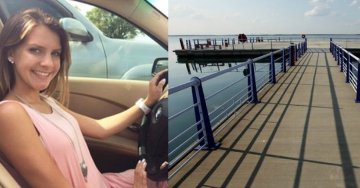Electric Shock Drowning
Details on ESD fatalities and near misses.
Teen Jumps Into Lake & Didn’t Come Out, Had No Clue What Was Under Water
Posted on April 28, 2016 by Amanda Shea
In Alabama, two friends jumped off the dock together into the lake, celebrating the start of the warm spring months with a cool dip. However, only one of the girls came back up, not knowing what was underneath the water in the spot where she took the plunge.
Carmen Johnson, a 15-year-old Priceville High School cheerleader, had just enjoyed a picnic with friends at Smith Lake, when she and another girl decided to go for a dip. As the pair swam in the area near the dock they jumped from, Carmen went underwater and never came back up, until a rescue crew recovered her deceased body. Without warning, the bubbly beautiful girl was dead in just a few short seconds, and it was caused by a very sneaky killer that she had no clue was under water.
The cheerleader had mysteriously drowned without apparent cause, until authorities discovered the hidden danger near fresh water docks, marinas, and boats, which once wasn’t an issue. According to Fox13, Carmen was killed as a result of electric shock drowning (ESD) from electrical currents in the water “leaking” from the increasing number of electric appliances and devices on boats and docks. The result was essentially as if she had jumped into the bathtub with a plugged in hairdryer.
Poorly installed or non-maintained electrical devices in or near the water are a serious danger to anyone who comes near it, since the current coming from them seeps into the water and can’t be felt until it is too late. Electricity that escapes into the fresh water immediately searches for a conductor, which in this case was a human body. Anybody can become a conductor to this charge if they are too close to the source, and once the electricity passes through the body, it can cause muscular paralysis, drowning, and even death, Independent Journal Review reported.
To make matters more concerning, there is typically no warning that the water is electrified, since there is not a visible change in conditions. The area appears completely safe until someone turns an electrical device on, without knowing the current it could put in the water, and a swimmer is electrically shocked from it.
Typical oversights that cause the currents to go rogue from the device and get into the water are frayed wires, improper installation, and a malfunctioning grounding system. The best form of prevention is regular checks and upkeep of these things, but since people typically dock their boat for months to store it through the season, these things often go unnoticed.
Regardless of posted warning signs of this danger, maintenance suggestions, and informed safety practices, chances are, there will be more ESD deaths, just as there were before Carmen died. Carelessness on either the boat/dock owners part and/or swimmers will always occur, despite what people are told to consider.
For this reason, along with the inability to detect the threat before it’s too late, perhaps swimming right around docks should be restricted or closely monitored for safety. There’s plenty of beach and other areas of the lake to enjoy a dip, and it’s just better to play it safe, rather than be sorry.
Carmen Johnson Alabama 15 year old Lewis Smith Lake ESD April 16, 2016
Monday, May 2, 2016
7:15 AM
Remembering Carmen Johnson: Priceville teen drowns in Smith Lake while swimming with family
Posted 5:48 pm, April 16, 2016, by Chris Davis and Hannah Ward, Updated at 11:02pm, April 16, 2016
WINSTON COUNTY, Ala. - The Alabama Law Enforcement Agency says a swimming incident on Lewis Smith Lake claimed the life of a Hartselle teen Saturday afternoon.
15-year-old Carmen Elizabeth Johnson drowned while swimming with family off a boat dock at a residence near Double Springs in Winston County. ALEA was called to the scene around 12:45 Saturday afternoon. Johnson was pulled from the water around 2:45 p.m. and she was pronounced dead on the scene.
Family members on Facebook say Johnson had been electrocuted in the water.
ALEA's Marine Patrol Division is still investigating.
Remembering Carmen Johnson
Carmen was a cheerleader for Priceville High School. “That smile, fun, ready to laugh," says Denise Neils. Herself, along with Jamie Weathersby Smith say the high school sophomore took her cheerleader enthusiasm with her into the classroom. “When something had happened, she would be the one that eased the kids and would say hey - everything’s going to be okay," says Smith.
Smith taught Carmen in the 6th and 7th grade. “She’s just so special to my heart and she is one of the most precious, sweet children I’ve ever taught in all 26 years that I was a teacher," she says.
Emma Hopkins and Alex Terry began cheering with Carmon their 8th grade year, and say Saturday's news was heartbreaking. “You never saw it coming, we were talking to her last night, it was so sudden and that’s one of the things that makes it so hard," says Terry.
Some of her classmates came together in prayer Saturday afternoon. “I went to the prayer club at Veterans today and there was so many people, the whole pavilion was filled up, and that shows you how close everyone really is," says Emma Hopkins.
Now, they must come to grips with saying goodbye to the best flyer on their cheerleading squad. Her former teachers hope the community will support each other, yet again. “There’s a lot of love in this community and when one part of the family hurts, the whole family hurts," says Neils.
Morgan County Superintendent Bill Hopkins said grief counselors and local youth pastors would be available to kids at the middle and high school.
Safety Suggestions by Beth A. Leonard from Boat US Seaworthy dated July 2013.
In general ESD victims are good candidates for successful Cardiopulmonary Resuscitation (CPR). Learn to perform CPR and maintain your training. To retrieve a person in the water, reach, throw, and row, but don’t go. Tell others about ESD. Most people have never heard of it and are unaware of the danger. Make sure your children understand the importance of not swimming anywhere there could be electricity. Don’t let them roughhouse on docks. Tell them what to do if they feel a tingling or shock in the water (see below). NEVER swim within 100 yards of any freshwater marina or boatyard. Talk to marina owners or operators about the danger of ESD. Ask your marina operator to prohibit swimming at their facility and post signs. Ask marina operators if they are aware of and following the guidelines from NFPA 303 (Fire Protection Standard for Marinas and Boatyards) and National Electric Code (NEC) 555. Have your boat tested once a year to see if it is leaking electricity, or buy a clamp meter and test it yourself. If you find any problems, have your boat inspected by a qualified electrician trained to ABYC standards. Have a qualified ABYC electrician install an ELCI on your boat (refer them to the ABYC E-11 Standard) or use an ELCI in the shore power cord. As an alternative, install an isolation transformer on the boat. Test the GFCI/ELCI at least once a month or per the manufacturer’s specifications. DO NOT do your own 120-volt AC electrical work on a boat or hire an electrician who is not familiar with ABYC standards to do it. Many of the problems that lead to electrical faults result from the differences between shore and boat electrical systems and standards. DO NOT use common household extension cords for providing shore power to your boat. Use, and encourage other boaters to use, shore power cords built to UL standards. NEVER dive on your boat to work on underwater fittings when it is plugged in to shore power, even in saltwater. NEVER swim within 100 yards of ANY dock using electrical power! If you have not electrified your dock or put an AC system on your boat, weigh the risks carefully before doing so. If you need electricity on your dock, hire a licensed electrician and make sure the wiring meets the requirements in NFPA 303 and NEC 555. If your dock is already wired, hire an electrician to check that it was done properly. Because docks are exposed to the elements, their electrical systems should be inspected at least once a year. Exercise your GFCIs/ELCIs as recommended by the manufacturer. If you normally run a power cord from your house or garage to charge your batteries, make sure the outlet has a GFCI and include an ELCI somewhere in the shore power cord. NEVER swim off your dock without shutting down all shore power to the boat and the dock. Even if you adhere to all of these rules, nearby docks can still present a shock hazard. Educate your neighbors and work together with them to make the waterfront safe. If you are in the water and feel tingling or shocks DO NOT follow your instinct to swim toward the dock! SHOUT! Drowning victims cannot speak, let alone shout. Let everyone know what’s happening so they’ll understand the danger and react appropriately. Try to stay upright and back out of the area the way you came, warn any other swimmers in the area of the danger, and then head for shore 100 yards or more from the dock. Alert the dock or marina owner and tell them to shut the power off to the dock until they locate the problem and correct it. Go to the hospital to make sure there are no lingering effects that could be dangerous Know how to distinguish drowning from ESD (see Alert for how to recognize “normal” drowning; tingling, numbness, or pain all indicate ESD). Fight the instinct to enter the water — many rescuers have died trying to help ESD victims. Call for help. Use 911 or VHF Channel 16 as appropriate. Turn off the shore power connection at the meter base and/or unplug shore power cords. Get the victim out of the water. Remember to reach, throw, row, but don’t go. If the person is not breathing or you cannot get a pulse, perform CPR until the Fire Department, Coast Guard, or ambulance arrives. (The full article is linked 4th spot down to the right)



